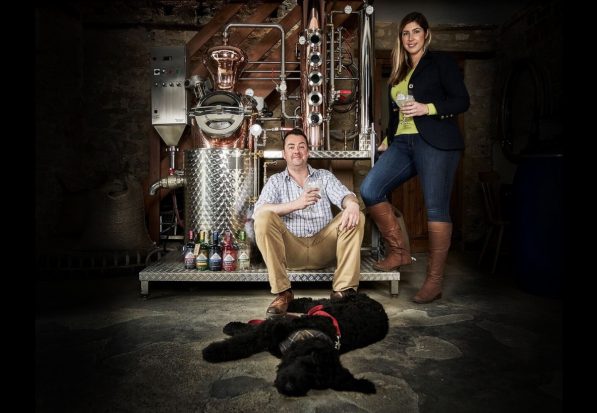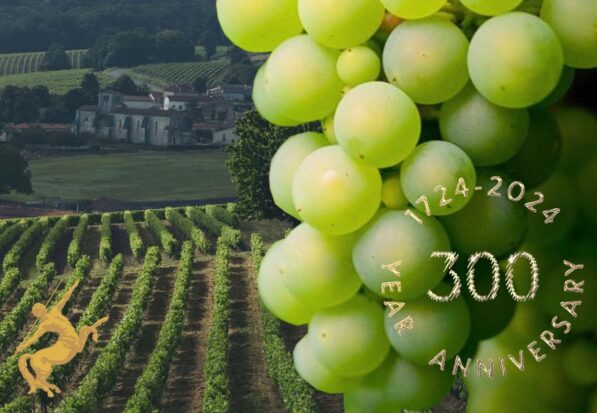The title ‘Gin Farmer’ may seem a little contradictory but not for Tom Warner from Warner’s Gin. Sure, he might have a distillery and be producing some of the U.K.’s most consumed gin, but primarily Warner is a farmer and it is that point that he thinks makes his gin so authentic.
The majority of his farm is devoted to the planting, growing and picking of the wide variety of botanicals he uses to make his gins. Among his crop are rhubarb, raspberries, lemon balm, lemon thyme, lemon verbena and an elderflower, not to mention blue cornflower, rose hibiscus, chamomile and lavender flower.
And the quality of his produce, and therefore ultimately his gin, is a responsibility he takes very seriously.
“At Warner’s, we make farm-born British gins. Everything we do is about Mother Nature at its best. No flavourings, no synthetics. The liquids are coloured because of the organic material that goes in them, not because we put a dye in there.”
Warner has been in Australia, promoting the brand’s Rhubarb Gin, and he is very keen to stress that you should not be fooled by the colour. Warner’s does not make pink gin. “It’s as if pink has become a flavour,” he said. “Pink isn’t a flavour, it’s a colour, but people are starting to shop the gin category by colour, which is just insane.
“It is criminal what’s going on in flavoured gin,” he continues. “It doesn’t seem to have hit in Australia yet. You guys are still at that awesome phase of having genuine small-batch producers making crazy good products.”
But Warner points out that in the UK, the flavoured gin category has become a massive problem. He sites a glut of products produced by those he describes as ‘slightly more cynical’ and that he thinks are simply capitalising on the good work that the craft industry has done.
“People are flooding the market with synthetically flavoured and coloured gins that are slammed with sugar, which is a real shame for the industry.”
While Warner may be here to promote a gin that looks pink, he stresses that all the colours in his gins do, in fact, come from nature. “Our rhubarb gin is pink because it’s got pure rhubarb juice in it. Our raspberry gin is quite a dark red because it’s got raspberry juice in it. It’s not because we’ve added a dye to either.”
It’s not surprising that Warner has such strong views on the ingredients of gin. Coming from a farming family, he has a strong connection to the land, and it was that love that got him into distilling in the first place.
“Agriculture in the UK is a lifestyle, not a living,” he explained. “It’s the craziest industry in the world, where you grow crops speculatively against an open market, never knowing how much you’re going to make.
… people are starting to shop the gin category by colour, which is just insane.
“For the future of the family farm, we wanted to bring in other revenue streams. We wanted to do something different to ensure the farm evolved.”
Initially, with a friend from agricultural college, one of the ideas they had was to create essential oils. Yet it was through doing a feasibility study into the distilling and then extracting of those oils, that distilling gin became a real consideration.
The year was 2012 and the law that required massive-sized stills for making gin and forbid small-batch distilling had changed only three years before. But still, independent distilling wasn’t as commonplace as it is now.
Unsurprisingly the boys quickly realised that it might be much more fun to actually use the still to make booze. “We thought we were the cleverest,’ he said. “We thought no one had thought of this at the time. We didn’t know anything about the law change, we were just excited about the idea of being a small independent producer.
“Most of the industry was owned by multinational, multi-billion pound turnover businesses. There weren’t many little guys with heart and soul trying to make amazing products. So we were very excited. Of course, it didn’t take us long to find out we weren’t the first in the UK, a couple of guys went before us, but we’ve been at the front of the category ever since.“
A pioneer in the flavoured movement, the Northamptonshire-based brand had a runaway success with their Rhubarb expression and in doing so, challenged the market share of long-established players.
Interestingly, the idea of adding flavours to their gins came to them by accident, much more than design. Warner tells a story of his mother buying a bottle of gin (as they had not started distilling yet) and putting fresh elderflower into a bottle and macerating it for a fortnight before added a little bit of sugar.
“It was like an elderflower Old Tom,” he said, “but using the fresh elderflower from the farm. When we tasted it, we thought it was amazing, these were the sort of flavour we want to make.
“My mother was a keen cook and a keen gardener with lots of herbs on the farm. Sadly she’s passed away now, but I’ve now got six acres of botanicals on the farm, following on in a much bigger way with what she was doing for cooking at home.”
Growing the botanicals they need for their gins is important to Warner, as he sees it as a continuation of a family legacy. And ensuring those botanical make up a substantial part of their gin is also a driving force. “With our Rhubarb gin, for example, a third of the bottle is rhubarb juice.
“We didn’t make the gin because we thought rhubarb would be popular. We didn’t do it because we thought it would be pink and that would be popular. We did it because we got offered a very special rhubarb crop from a crown estate in Lincolnshire from Queen Victoria’s garden.
“There was only three tons of this stuff. That’s all there was. So we produced a limited edition batch with the rhubarb, and it went crazy. We don’t use that crop anymore, as we are growing our own Rhubarb in a five-acre plot we fenced off this spring.”
Warner explains that the Rhubarb is harvested between May and August. It is frozen; then when it comes out of the freezer, it’s thawed and put through a cider press to get the juice.
 PIN IT
PIN ITRhubarb crop
“So instead of using the spring water on the farm like we do to cut our London dry, which comes off the seal around 89%ABV, we use pure rhubarb juice to cut the gin to bottle strength.
As unusual as this practice is, it’s all part of the brand’s belief in doing things a little differently. For Warner, farming his gin is not just about authenticity but also increasing the farm’s biodiversity, which has in turn created a symbiotic wheel.
“One of our gins is a honey gin, so the bees that pollinate the botanicals are also making the honey that goes into our honey gin. We have created this huge flavour distillation environment on the farm now, which is just awesome.”
But as Warner points out, becoming fully self-sufficient is a journey. “We did a garden at Chelsea Flower Show this year, it was a show garden, and we managed to get three juniper trees from Italy as part of the deck. So now we’ve got these three 30-year old juniper bushes from Italy growing on the farm.”
The company has also just won a Footprint Sustainability Award, an environmental award in the UK for the drinks industry. But Warner acknowledges that there is still a way to go.
“For us, it’s all about fruit content. It’s about British farm-born flavour. We are trying to connect people to what’s real and what truly matters in life. That’s what the brand’s about, in essence.
“We want people to know what they are drinking. And we want them to know that we’ve used the best ingredients, the best process, and the best equipment to make the best possible liquid,” he said.
Warner’s Rhubarb Gin Sour
Ingredients
50ml Warner’s Rhubarb Gin
25ml Lemon juice
20ml Sugar syrup
Dash angostura bitters
1 Egg white (optional)
Instructions
Shake all ingredients together with ice for 10 seconds. Double strain into the other half of the shaker and empty the ice. Dry shake for another 10 seconds and pour into a Coupette, garnish with the lemon twist.










